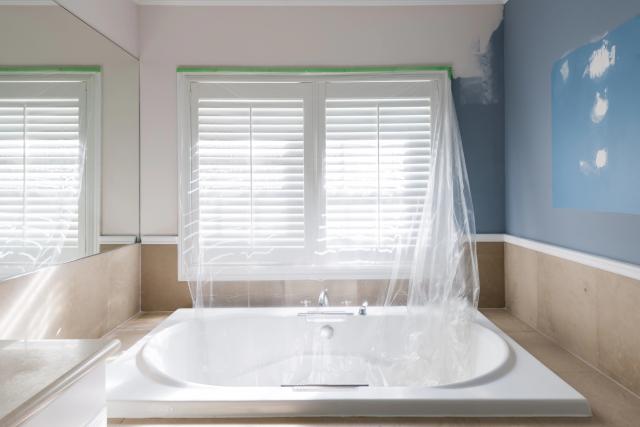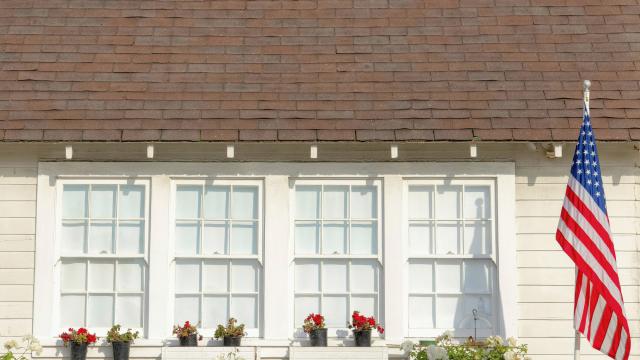
Best Paint for Bathroom: Expert Guide to Mold-Proof Walls
Bathroom walls face tougher conditions than any other room in your home. Steam from hot showers,...

Standard window sizes make the buying process easier, faster, and more affordable for most homeowners. These predetermined dimensions fit typical rough openings in residential construction, helping you avoid the premium costs that come with custom measurements. Most homeowners choose standard sizes when installing new windows or replacing existing ones. Window dimensions depend on the room's purpose and the age of your home. Bathroom windows typically measure 24–36 inches wide and 36–72 inches high, while bedroom windows generally run 20 inches wide by 24 inches high. Standard single and double-hung window sizes vary from 2 feet wide by 3 feet high to 4 feet wide by 6 feet high. This guide covers everything you need to know about window sizing, from reading dimension codes to weighing standard versus custom options. You'll learn how to make informed decisions that balance cost, functionality, and your home's specific requirements.
Standard window dimensions form the foundation for most window installations in modern homes. Understanding these measurements helps you select the right window size and can save money during installation or replacement projects.
Standard window sizes are predetermined dimensions that manufacturers produce to fit typical rough openings in residential construction. These mass-produced dimensions cost less and are more readily available than custom options. The most common window size in U.S. homes measures 36 inches wide by 60 inches high, though this size won't work for every home.
Standard dimensions offer several practical advantages:
|
Benefit |
Description |
|---|---|
|
Cost |
Using standard sizes instead of custom options can save approximately $175 per window |
|
Availability |
Standard sizes are more readily stocked and accessible |
|
Installation |
An easier and faster installation process for contractors |
|
Accessories |
Simplified process for finding suitable window treatments |
Pro Tip: Older homes built before standard window sizes were established often require custom dimensions, which can increase replacement costs by approximately 50%.
Window manufacturers use a simple four-digit system to indicate dimensions. The first two digits show the window's width in feet and inches, while the last two digits show the height. Here are common examples:
Check with manufacturers whether these codes refer to the actual window size or the rough opening size, as this distinction prevents costly mistakes.
The rough opening is the hole in your wall where the window gets installed, while the actual window size refers to the physical dimensions of the window unit itself. The rough opening is typically half an inch larger than the actual window size on both width and height.
If your rough opening measures 50 inches by 40 inches, the actual window size would be approximately 49-1/2 inches by 39-1/2 inches. This difference creates 1/4 inch of space on each side when the window is centered in the opening.
Take three measurements for both width and height—at the top, middle, and bottom for width, and at the left, center, and right for height. Use the smallest measurement to ensure your window fits properly.
Different window types come with specific standard dimensions to match various architectural needs and room functions. Each type offers distinct advantages depending on your home's style and requirements.
Single-hung windows feature a stationary upper sash and a movable bottom sash. These traditional windows are typically taller than wide, making them ideal for rooms where vertical space is available but horizontal space is limited.
|
Standard Window Widths (inches) |
Standard Window Heights (inches) |
|---|---|
|
24, 28, 32, 40, 44, 48 |
36, 44, 48, 52, 54, 60, 62, 72 |
Popular single-hung dimensions include 2 feet wide by 3 feet tall (2030) and 2 feet wide by 4 feet 4 inches tall (2044). These windows work well in bedrooms, where standard sizes typically range from 24 to 34 inches in width and 36 to 62 inches in height.
Best for: Traditional homes and rooms with limited horizontal wall space.
Double-hung windows allow both the upper and lower sashes to move, offering superior ventilation control. They share many standard dimensions with single-hung windows but provide more flexibility in operation.
|
Standard Window Widths (inches) |
Standard Window Heights (inches) |
|---|---|
|
24, 28, 32, 40, 44, 48 |
36, 44, 48, 52, 54, 60, 62, 72 |
Common double-hung window sizes include 2 feet 8 inches wide by 4 feet tall (2840) and 2 feet 8 inches wide by 5 feet 2 inches tall (2852). These windows typically range in width from 24 to 48 inches and in height from 36 to 72 inches.
Best for: Most modern American homes due to their versatility and wide range of standard sizes.
Casement windows hinge at the side and swing outward like a door. They provide excellent ventilation and unobstructed views when open, though they require clearance space outside your home.
|
Standard Window Widths (inches) |
Standard Window Heights (inches) |
|---|---|
|
16, 20, 24, 28, 32, 36, 40, 44, 48 |
24, 36, 48, 54, 60, 72, 84 |
Popular casement dimensions include 2 feet 4 inches wide by 3 feet 6 inches tall (2436) and 2 feet 8 inches wide by 5 feet tall (2850). Smaller casement windows start around 1 foot 7 inches wide by 1 foot 4 inches high.
Best for: Areas requiring maximum ventilation and unobstructed views.
Sliding windows operate horizontally and typically have a wider-than-tall orientation. They're perfect for spaces where you can't open a window outward, such as above kitchen sinks or areas close to walkways.
|
Standard Window Widths (inches) |
Standard Window Heights (inches) |
|---|---|
|
36, 48, 60, 72, 84 |
24, 36, 48, 60 |
Common sizes include 36 x 36 inches, 48 x 36 inches, and 60 x 48 inches. These windows work particularly well for living rooms and basement bedrooms that need egress options.
Best for: Kitchen areas, tight spaces, and contemporary home designs.
Picture windows are large, fixed fixtures designed to maximize views and natural light. Since they don't open, they can be manufactured in larger sizes than operational windows without structural concerns.
|
Standard Window Widths (inches) |
Standard Window Heights (inches) |
|---|---|
|
24, 34, 36, 48, 60, 72, 96 |
12, 24, 36, 48, 60, 96 |
Popular picture window dimensions include 3 feet wide by 2 feet tall (3020) and 6 feet wide by 4 feet tall (6040). Some manufacturers offer sizes up to 8 feet wide by 10 feet high for dramatic views.
Best for: Living rooms, dining rooms, and spaces where maximizing natural light and views is the priority.
Beyond the popular window styles like single-hung, double-hung, casement, sliding, and picture windows, several other types offer specialized functionality and aesthetics suited for specific spaces:
Awning windows are hinged at the top and open outward from the bottom, allowing ventilation even during light rain. They’re often used in bathrooms and basements due to their compact size and privacy-friendly design.
|
Standard Window Widths (inches) |
Standard Window Heights (inches) |
|---|---|
|
24–46 |
20–36 |
Best for: Bathrooms, basements, or high-set windows that require airflow.
Basement windows are inward-opening and typically placed near the ceiling in basements. Their compact, horizontal design makes them ideal for limited wall space.
|
Standard Window Widths (inches) |
Standard Window Heights (inches) |
|---|---|
|
30-36 |
12-24 |
Best for: Basement applications where natural light and minimal ventilation are desired.
Garden windows project outward from the home and create a small shelf-like space ideal for plants or herbs. They let in ample light and are usually found in kitchens.
|
Standard Window Widths (inches) |
Standard Window Heights (inches) |
|---|---|
|
36-72 |
36-60 |
Best for: Kitchens or areas where sunlight and display space are valued.
These custom-built windows consist of multiple panels angled to create a rounded or polygonal projection from the home. They are highly decorative and ideal for creating reading nooks or expanding the sense of interior space.
Sizes vary by design and manufacturer. Width and height are typically custom-made.
Best for: Living rooms, dining areas, and other prominent spaces.
Pro Tip: When choosing windows for bedrooms, it’s essential to consider local building codes, particularly for egress purposes. A standard bedroom window size often falls within the 24–36 inch width and 36–60 inch height range, offering both functionality and safety.
Standard window sizes chart
|
Window Type |
Width (inches) |
Height (inches) |
Common Room Usage |
|---|---|---|---|
|
Bathroom |
24 – 36 |
36 – 72 |
Bathrooms |
|
Bedroom (egress) |
20 – 36 |
24 – 60 |
Bedrooms |
|
Single-Hung |
24, 28, 32, 36 |
36, 48, 54, 60, 72 |
Most rooms |
|
Double-Hung |
24 – 48 |
36 – 72 |
Bedrooms, living rooms |
|
Sliding (Horizontal) |
36 – 84 |
24 – 60 |
Living rooms, basements |
|
Casement |
14 – 36 |
24 – 84 |
Kitchens, bedrooms |
|
Picture (Fixed) |
24 – 96+ |
12 – 62+ |
Living rooms, stairwells |
|
Bay/Bow Windows |
Varies (custom) |
Varies (custom) |
Living rooms, dining areas |
|
Awning Windows |
24 – 46 |
20 – 36 |
Bathrooms, basements |
|
Basement Hopper |
30 – 36 |
12 – 24 |
Basements |
|
Garden Window |
36 – 72 |
36 – 60 |
Kitchens |
Choosing between standard and custom windows depends on your home's age, condition, and specific requirements. This decision impacts your budget, timeline, and long-term satisfaction with the installation.
Standard windows work well for most modern homes built after standardized construction practices became widespread in the 1970s. These mass-produced options are ideal in several situations, such as when you're replacing windows in newer homes where framing dimensions are consistent, undertaking new construction projects where you can plan for standard dimensions, or dealing with urgent repairs that require fast turnaround.
Because common window openings often follow a predictable layout, using a standard window size in feet—like 2x3, 3x4, or 4x6—helps streamline the selection and installation process. This simplifies your project and reduces the need for structural modifications. Standard sizing also ensures easier compatibility with off-the-shelf window treatments, insulation, and trim kits.
Pro Tip: Even though these windows are standard-sized, they're usually made to order after purchase. The difference is that they're manufactured using pre-defined dimensions, which makes the production faster and more affordable than fully custom windows. This balance between efficiency and flexibility makes standard window sizes in feet a smart, cost-effective solution for most homeowners.
Custom windows become essential in several situations, particularly with older properties. You'll need custom dimensions when:
Proper fit matters because even small gaps can create air leaks that affect both comfort and energy efficiency.
The differences between standard and custom options are significant:
|
Factor |
Standard Windows |
Custom Windows |
|---|---|---|
|
Cost |
$100-$400 per window |
$300-$4,000 per window |
|
Manufacturing Time |
4-6 weeks |
4-15 weeks (some up to a year) |
|
Installation Time |
Faster, often same-day |
Longer, requires precise fitting |
|
Long-term Value |
May require retrofitting |
Better energy efficiency, fewer repairs |
Custom windows typically cost approximately 50% more than standard sizes, but this investment often pays off through improved performance and longevity.
Accurate measurements are critical for custom window success:
Incorrect measurements can lead to costly adjustments, gaps, and poor insulation.
Choosing the right window size affects both your home's appearance and energy efficiency. Windows of a standard size offer significant cost savings, faster installation, and easier access to window treatments compared to custom alternatives. Understanding dimension codes and the difference between rough openings and actual window measurements helps you avoid costly installation mistakes.
Different window types serve different purposes in your home. Single-hung and double-hung windows work well for most rooms, while casement windows provide excellent ventilation. Sliding windows suit spaces where outward-opening windows won't work, and picture windows maximize views and natural light.
Most modern homes accommodate standard dimensions perfectly, saving homeowners approximately $175 per window compared to custom options. Older homes built before the 1970s often need custom solutions despite the higher cost and longer wait times.
Measure your window openings carefully before making purchases. Take multiple measurements at different points to ensure proper fit, whether you choose standard or custom sizes. Accurate measurements lead to better energy efficiency and fewer future repairs.
You can now make informed window decisions for your home improvement projects. Balance cost considerations with your home's specific requirements and your aesthetic preferences to choose the best windows for each room.
GET THE ESSENCE OF RELEVANT HOME
IMPROVEMENT TOPICS IN LESS THAN 5 MINUTES

Best Paint for Bathroom: Expert Guide to Mold-Proof Walls
Bathroom walls face tougher conditions than any other room in your home. Steam from hot showers,...

Roll roofing provides an economical and practical solution for covering low-slope roofs, making i...

Thanks for joining our homeowners’ community.
Stay tuned!
Choose the category
Choose the category